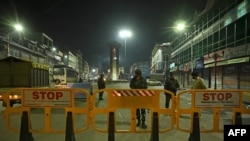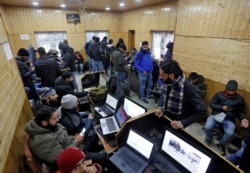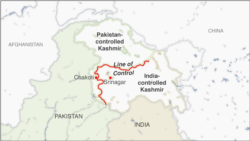News outlets in the Indian-controlled region of Kashmir are under rising financial pressure, as authorities bar more than 30 media houses from state advertising.
The region’s Department of Information and Public Relations this month removed 10 newspapers in Kashmir and 24 publications in the Jammu region from a list of outlets approved for state ad revenue — known as being empaneled — following a meeting late last year.
Although some were removed for not meeting requirements on areas such as circulation, several were told they had allegedly violated a media policy implemented in May.
Under the new media policy, the region’s director of information has power to immediately suspend advertisements if a publication is deemed to have misrepresented information, violated a guideline or failed to meet standards, including minimum circulation figures.
The policy states it was introduced to build public trust, raise awareness of government initiatives and combat fake news or attempts to use media to incite or “propagate any information prejudicial to the sovereignty and integrity of India.”
The media policy and allocation of government advertising raises two key issues, media analysts and press groups say. First, the loss of an important source of income for many of the region’s papers could lead to journalists being laid off. Secondly, publishing houses could make cuts to the number or size of editions printed, or even be forced to close news outlets. It could also encourage self-censorship.
The move is seen as yet another means for India to put pressure on news outlets in Kashmir. Journalists in the region have faced increased attacks, detentions and pressure, as well as an ongoing ban on high-speed internet since India’s prime minister revoked Kashmir’s special status in August 2019.
By repealing the status, India stripped the Muslim majority state of autonomy, including the right to its own constitution and independence to set its own laws and policies.
The media watchdog Reporters Without Borders said the clampdown on access to information in the region “heavily affected” India’s ranking on its World Press Freedom Index last year. The country fell to 142 out of 180 countries, where one is the “most free.”
India claims the measures are needed to stop the spread of false information and to bring stability to the region, which is claimed by both India and Pakistan and has been affected by turmoil and separatist fighting.
India’s directorate of information and public relations did not respond to VOA’s emails requesting comment.
Shuja ul Haq, president of the Kashmir Press Club, told VOA his association believes the media policy is problematic for journalism in Jammu and Kashmir.
“If some publications violated norms of circulation like not publishing or not being available in the market as government claims, then action against them could have been taken. However, the fact that notices have been issued to newspapers on their content is unprecedented,” Haq said.
The press club has been flagging potential issues with the policy from the start, Haq said.
“[If] the government starts deciding what is right and what is not worth publication, then the whole idea of freedom of press and expression is violated,” Haq said.
The withdrawal of official advertising such as planning notices is a tactic used by governments around the world to apply financial pressure on news outlets, often when their coverage is critical of governmental positions, said Rachael Jolley, a research fellow at the Center for Freedom of the Media at Sheffield University and former editor in chief of the Index on Censorship magazine.
“It is deeply worrying that the Jammu and Kashmir government is withdrawing advertising from newspapers at this critical time, when the public needs independent news to tell them what is going on with COVID in their communities. A lack of access to news could leave people's lives threatened,” Jolley said.
Anuradha Bhasin, a vocal journalist and editor of the daily Kashmir Times, said she has been facing the brunt of financial pressure from the government since she challenged the communication ban at the Supreme Court of India.
“The government of India has stopped advertisement for my publication since August 10 and is pushing us to the wall, thereby making it financially difficult for us to continue [publishing],” Bhasin said.
The tactic of denying government advertising is not new for the group — one of its regional newspapers was forced to close in 2018 because of a cut in funds. But the media policy gives a wider scope for officials to cut papers off from ad revenue, Bhasin said.
“The de-empanelment of Dainik Kashmir Times puts an official stamp on the denial of advertisements,” Bhasin said, referring to a notice served to the paper’s daily Hindi-language publication.
The paper was removed for not meeting minimum circulation requirements.
The objective of these regulations is to control the narrative and have a complete surveillance of news organization, she said.
Fahad Shah, founder and editor of The Kashmir Walla magazine, told VOA that media cannot be independent and receive ad revenue from the Indian government.
“I think these newspapers were empaneled by the government as per the requirement of the government, and when they didn't even fulfill those requirements, they were discontinued from taking ads,” Shah said. “It won't affect independent reporting, as we don't have any concern with government advertisement. Free media is possible only by a public-funded model.”
While The Kashmir Walla is not affected by the de-empanelment, it has faced pushback in other forms.
The magazine’s Twitter account was suspended on December 31 after it retweeted one of its articles alleging that Indian security forces used excessive force against a religious procession in Kashmir.
Daniel Bastard, Asia-Pacific director of Reporters Without Borders, said the withholding of state advertising revenue in India appeared to be “very specific” to Kashmir.
Bastard cited previous instances where the Jammu and Kashmir government withdrew advertising on spurious grounds. In March 2019, both Greater Kashmir and Kashmir Reader were suddenly and arbitrarily deprived from any public advertising income, Bastard said.
Bastard said pressure through advertising is an old practice in the region.
“It is a very shabby way to put pressure on newspapers who don't toe the line of the government. It gravely endangers the economic viability of the targeted media outlets, and as such, it is a major violation of press freedom,” he said.
Aliya Iftikhar, senior Asia researcher at the Committee to Protect Journalists, told VOA the use of vague reasons to block dozens of news outlets to state advertising was alarming. She said the administration is moving ahead with a new media policy without soliciting input from stakeholders or taking on board criticisms and feedback from civil society.
“Actions like this decrease the space for a free and independent press in the region, which is more critical than ever,” Iftikhar said.








